I seldom see ladybirds nowadays, so I was pleased when I noticed this pair of ladybirds when I was doing some planting in the veggie patch. They were rapidly twirling and whirling as they made the way up and down the stalks. Oh good, I thought, they might munch some of the aphids, but I just hope they are not ladybirds of the invasive alien kind.
So I looked them up. Insofar I as could tell these are Lunate Ladybirds (Cheilomenes lunata) (thanks to https://southafricaninsects.wordpress.com/beetles-coleoptera/). These ladybirds occur across much of southern Africa and in parts of western, central and eastern Africa too. Their main prey is aphids.
On the same day in the veggie patch, I saw another ladybird too, and unfortunately this turned out to be the invasive Harlequin Ladybird (Harmonia axyridis), also known as the Asian or Multicoloured Asian Ladybird (or Ladybeetle or Ladybug). In parts of North America it is also known as the Halloween Ladybeetle. This ladybird is native to Asia.
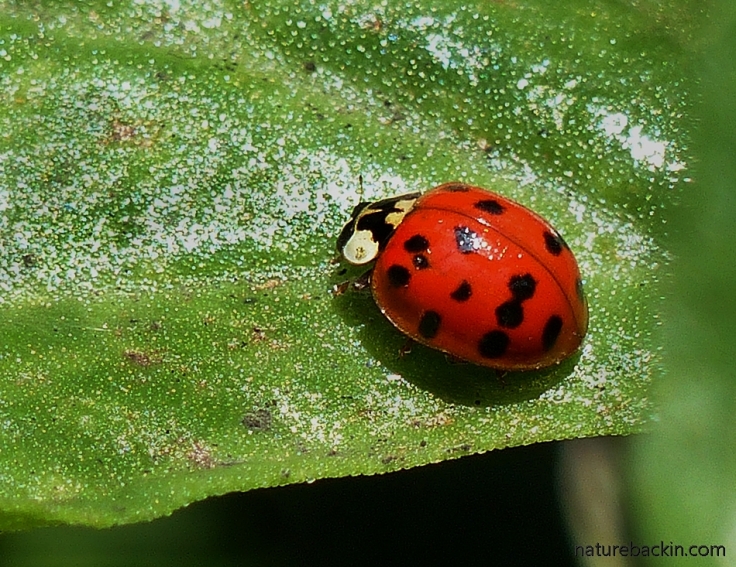
Highly variable in colour, the Harlequin Ladybird can be identified by a black “W” or “M” marking on its broad “neck” (pronotum), the area behind its head. In this photo you can just see the black “W” on the white pronotum
In some countries, including in North America, the Harlequin Ladybird was deliberately introduced to assist in aphid control. Although it has been effective in this role, unfortunately it has since become highly invasive.
In South Africa the Harlequin Ladybird was first noticed in the Western Cape in the early 2000’s and has since spread across the country. Although in summer they eat aphids and other insects, including the young of ladybirds, in winter the Harlequin Ladybird can have a detrimental effect on the agricultural industry, eating plants and fruit including grapes. When crushed with grapes used in winemaking they can taint the wine. The ladybird’s ability to exude an unpleasant substance when threatened, known as reflex bleeding, makes the taint significant. That ladybirds are usually brightly coloured in shades of red, orange or yellow, their brightness advertising their unpleasantness to would-be predators.
According to the website, Invasive Species South Africa, the Harlequin Ladybird, “negatively impacts pristine grassland and agricultural crops, as it is a voracious generalist. It can occur in large densities and compete against other indigenous insects”. They are outperforming and so displacing native species, and there is evidence that they are carriers of tiny parasites that do not affect them, but they can lethally infect native species of ladybirds. Not only can they occur in high numbers, breed rapidly and have voracious appetites, Harlequin Ladybirds can also tolerate a wide spectrum of climatic conditions.
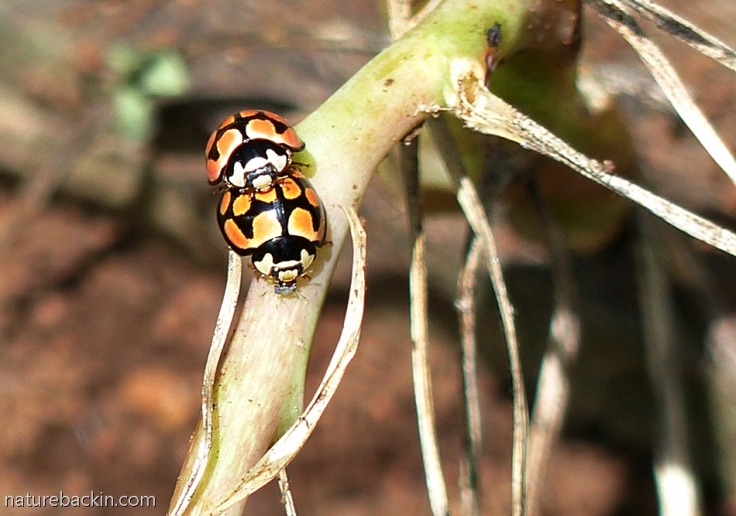
The Lunate Ladybird (Cheilomenes lunata), native to South Africa and other African countries, specialises in eating aphids. Aphids are sap-suckers that can weaken and damage the plants on which they feed
Native ladybirds, among other insects, play an important ecological role and many species are beneficial to sustainable agriculture and gardening. In addition to being threatened by Harlequin Ladybirds that are invasive aliens outside of Asia, worldwide, ladybirds are also under threat from the use of pesticides. Unfortunately, pesticides used to kill unwanted insects also kill beneficial insects. Organic sprays also kill beneficial insects, including ladybirds, so think twice before spraying pesticides in the garden.
For more information on biological pest control and ladybirds see this interesting blog post at Whisker Flowers, a blog about urban homesteading and kitchen gardening in South Africa.
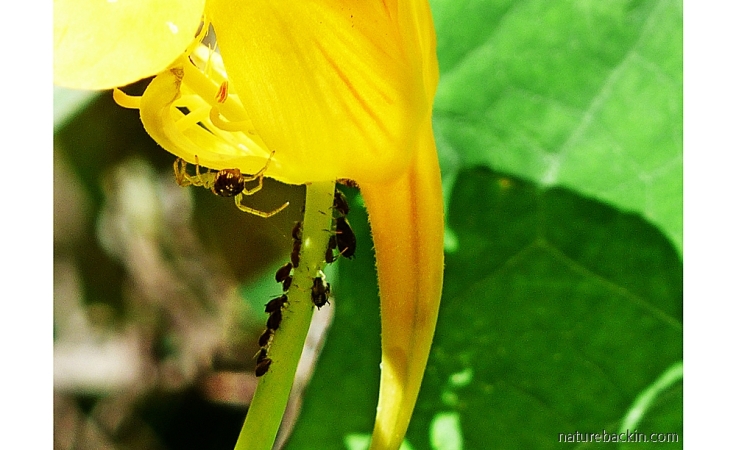
These black aphids are starting to colonise a nasturtium plant. Note also the unidentified tiny spider, most likely seeing the aphids as prey. Spraying the aphids with pesticides would also kill the spider. I plant nasturtiums in the veggie garden as aphid trap plants. They attract aphids away from the vegetable plants, and when they are infested with aphids, I simply roll up the plants and remove them
On the same day when I photographed the ladybirds in the vegetable patch, I also noticed several long and segmented black and yellow creatures clambering about on the New Zealand spinach. Not knowing what they were, I snapped some pictures. A few days later I was paging through Jason Londt’s handy little book, Suburban Wildlife in KZN, and came across a photo of a larval ladybird, and that solved the mystery. So, coincidentally and on the same day, I noticed and photographed adult ladybirds and larval ladybirds without realising the connection at the time.
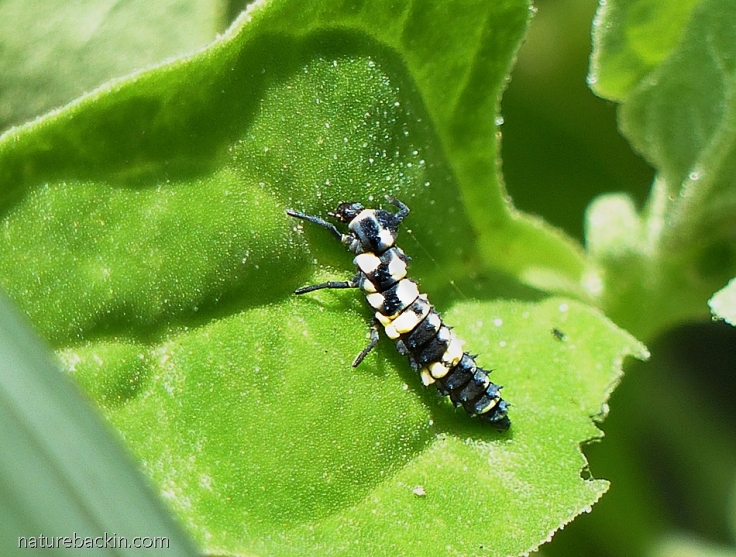
A ladybird in its larval stage. Turns out that this is one of the larvae of the Lunate Ladybird (Cheilomenes lunata)
As far as I have been able to find out, the larvae of the Lunate Ladybird also eat aphids. The larvae hatch from eggs and when fully grown they form pupae that go on to develop into the familiar adults.

Two larval Lunate Ladybirds on a spinach plant. The one in the picture on the right has a black aphid next to its second leg, and dangling below is the exoskeleton of an aphid
The Ladybird Project is dedicated to protecting ladybirds and informing people about them. It advocates for ladybird-friendly gardening practices and suggests keeping a ladybird-friendly corner of the garden to attract ladybirds. Such a corner can be planted with plants that attract ladybirds and of course no pesticides are used.
In addition to not using pesticides, other suggestions (see here) are to plant strategically to avoid insect infestations and to use plants that deter unwanted insects such as aphids. If necessary ladybird-friendly sprays may be used.
The terms ladybirds, ladybugs and lady beetles are all used synonymously, with the name lady beetle being the most accurate, as they are indeed beetles. The ‘lady’ part of the name is thought to derive from the fact that the commonest ladybird in England (and Europe) has seven black spots on its wing covers. In the context of Christianity, these seven spots were linked to the seven sorrows of “Our Lady”, the Virgin Mary, who was commonly depicted wearing a red cloak the same colour as the Seven-spot Ladybird.
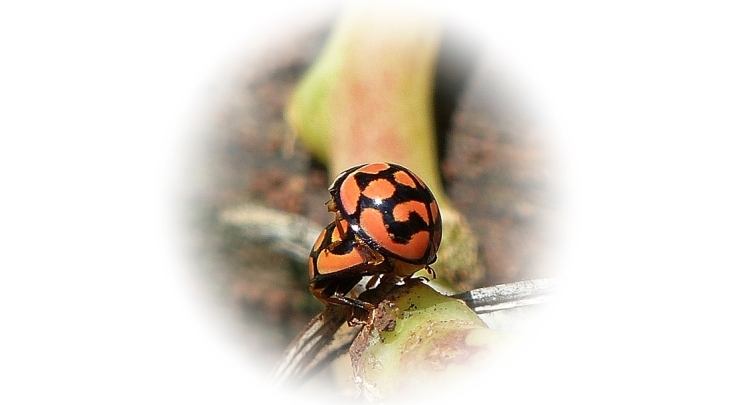
Sources: Clusella-Trullas, Susana, Logan, Michael and Minnaar, Ingrid A. 2015. Ladybirds: successful invaders in small packages. Quest 11(2) 8-10. http://academic.sun.ac.za/cib/quest/articles/P8-10.Ladybirds.pdf; Invasive Species South Africa. 2018. Harlequin ladybird citizen science project. http://invasives.org.za/legislation/item/1239-harlequin-ladybird-citizen-science-project-launched; Ladybird Project. 2018. http://theladybirdproject.org.za/; Londt, Jason. 2009. Suburban Wildlife in KZN. A Wildlife Handbook, WESSA KZN; Whisker Flowers. 2017. Ladybeetle (Ladybug or Ladybird): Biological Control – Garden Critter of the Month. https://whiskerflowers.wordpress.com/2017/11/18/ladybeetle-ladybug-ladybird-biological-control-garden-critter/
Posted by Carol









November 4, 2018 at 10:21 pm
Those little invaders are really getting around! They are causing concern here in the UK too, displacing native species at a rate of knots – I’ve seen them in London and they’re thriving up here in North Wales too.
LikeLiked by 1 person
November 5, 2018 at 8:49 pm
Strange how they adapt to and thrive in such a variety of places and climates.
LikeLike
October 13, 2018 at 4:41 pm
Hey hey! Thanx for the mention! 🙂 Will be dropping by often to check out what you get up too!
LikeLike
October 14, 2018 at 4:49 am
That’s good. Thanks!
LikeLiked by 1 person
October 6, 2018 at 3:41 am
Your ladybirds look quite different from the ones we call ladybugs here. I posted about a hatch I found of ladybugs along a river in a forest in the mountains (at: https://gusgus64.wordpress.com/2013/03/24/springtime-popping-out-all-over/) They really don’t look much like yours. I’m pretty sure it was during the spring thaw. The two photos were shot in way back times when I lived in the Sierra foothills (around the late 1970s- back in the days when slides weren’t digitally marked with dates! 😀 ).
LikeLiked by 1 person
October 9, 2018 at 4:30 am
Thanks for the interesting link.
LikeLiked by 1 person
October 6, 2018 at 3:41 am
Wow, Carol, what a fascinating post!!! Thanks for putting it together so beautifully. While I knew what ladybird larvae looked like I had no idea that we have invasive alien ladybirds in our country, and what a massive threat they are to our agriculture and ecosystems!
LikeLiked by 1 person
October 9, 2018 at 4:23 am
Thank you. Another complicated scenario!
LikeLiked by 1 person
October 5, 2018 at 9:51 am
Lovely post.
LikeLiked by 1 person
October 5, 2018 at 2:37 pm
Thanks Sherry.
LikeLike
October 5, 2018 at 7:45 am
I hadn’t realsed there were so many varieties of ladybird. Of course, here they are regarded as the gardener’s friend, but I clearly remember one year, maybe 25 years ago, when there was an invasion of them in Norfolk, where we were on holiday. You had to carry a duster round to sweep surfaces clean that you planned to sit on. They covered everything, from car windscreens to children’s play equipment in playgrounds in a thick, whirring crust. Extraordinary.
LikeLiked by 1 person
October 5, 2018 at 6:09 am
Great photos and information. Bugs are so interesting, but it’s so easy for something harmful to be introduced to a country. It’s a constant struggle, here in Hawaii, to protect and support native insects that are being overrun by invasive species.
LikeLiked by 1 person
October 5, 2018 at 2:30 pm
Thanks Graham. It is a perplexing problem.
LikeLiked by 1 person
October 4, 2018 at 10:12 pm
Yes, we have a ton of the Asian invasive kind and I seldom see the natives anymore. They hibernate in eaves and sheds and come inside through cracks where they congregate in corners. In spring, they ‘wake up’ and start moving towards windows to try to get out. I collect them the best I can, without triggering their stench, which can be powerful. I didn’t realize that they eat fruit and crops. They certainly would ruin any wine!
LikeLiked by 1 person
October 5, 2018 at 4:51 am
I wonder if your colder winters induce them to hibernate during the winter and so not eat crops, unlike here where they can still be active during the winter? I have not seen any such congregations in our region – yet. Hard to imagine!
LikeLike
October 4, 2018 at 9:28 pm
I shall have to go out and check my ladybirds, Carol as I’ve seen some on the roses which have been covered with an alarming number of aphids.
LikeLiked by 1 person
October 5, 2018 at 4:46 am
Hopefully the ladybirds will make a dent in the aphid population! Do you ever try hosing off the aphids with a jet of water from a garden hose?
LikeLiked by 1 person
October 5, 2018 at 7:27 am
Yes I did exactly that, and I’m keeping an eye out for more…may need a second hosing.
LikeLiked by 1 person
October 4, 2018 at 8:59 pm
Very interesting – thank you for pointing out the differences.
LikeLiked by 1 person
October 5, 2018 at 4:43 am
Thanks. I learnt a lot reading for this post!
LikeLike
October 4, 2018 at 8:43 pm
Great post. Never realised the Harlequin was an invasive species.
Are we advised to destroy them?
LikeLiked by 1 person
October 5, 2018 at 4:39 am
Thanks Ark. I have not seen that advised specifically. However, see this link for info on how to contribute to research. http://invasives.org.za/legislation/item/1239-harlequin-ladybird-citizen-science-project-launched
LikeLiked by 1 person